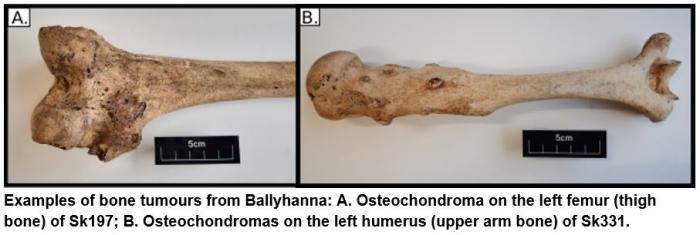Genetic Bone Tumours in Medieval Donegal
By Iseult Jackson of the Smurfit Institute of Genetics, Trinity College Dublin
Life was tough in County Donegal 1,000 years ago. In a medieval church graveyard at Ballyhanna in Ballyshannon, excavated in 2003 prior to the construction of the N15 Bundoran–Ballyshannon bypass, those buried here showed high rates of skeletal indicators of stress and ill health. This Gaelic medieval population would have included tenant farmers, labourers, merchants, artisans, clergy, and the very poor.
For two individuals from this graveyard (skeletons Sk197 and Sk331), life was particularly challenging. These two men both had multiple osteochondromas—a genetic disease—that resulted in multiple tumours in their bones, as shown in the examples photographed below. This condition is rare, can be extremely painful, and can lead to limb deformity, reduced stature, nerve compression and, in approximately 5% of cases, malignancy.

These men lived about a century apart from each other and had different ranges of symptoms. The earlier individual (Sk197) lived around AD 689–975 and had a relatively mild form of the disease. He died at approximately 30–40 years of age and was of roughly average height for the Gaelic population at that time. His forearms had differences in their length and he had ‘knock knees’ due to his tumours. In contrast, the more recent individual (Sk331) had much more severe symptoms. He was of short stature and had a major deformity in his left arm due to shortening of the ulna (one of the forearm bones) and had tumours throughout his skeleton resulting in other deformities in his hips, knees, and left ankle. He died as a young adult, although he had no evidence for cancer in his tumours.
Today, although people with multiple osteochondromas suffer from similarly painful symptoms, they can be treated, where necessary, with surgery.
A major advance in modern medicine is the ability to sequence a patient’s genome to find the precise cause of a genetic condition. However, this type of comprehensive search has not yet been done in ancient individuals.
The analysis of these skeletons, part of the Ballyhanna Research Project, also included DNA sequencing of some of the individuals buried here. This research was recently published in the European Journal of Human Genetics and can be accessed here.

Genome sequences from the two affected skeletons were analysed and mutations were found in a gene called EXT1, which has been shown to be involved in this disease in modern patients. The mutations found in this gene were different in the two individuals: the earlier mutation has been identified in some patients today, but the other has not previously been seen in sequencing data.
This is the first time a new disease mutation has been discovered in ancient genomic data.
The disease only occurs in 1/50,000 people and when it is found within a modern locality the affected people tend to be related. It is very surprising that the same rare condition occurred twice in the same medieval parish but resulted from two different mutations.
Readers might also be interested in two books about the Ballyhanna Research Project: The Science of a Lost Medieval Gaelic Graveyard (published by TII in 2015), which draws together the various research strands to create a comprehensive overview of the graveyard and the life and times of those buried there, and Life and Death in Medieval Gaelic Ireland (published by Four Courts in 2018), which showcases the detailed osteological and palaeopathological analysis. Additional articles and papers related to the project can be accessed here. You can also listen to the Ballyhanna: stories from the grave audiobook.
(Posted 13 January 2023)